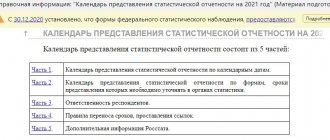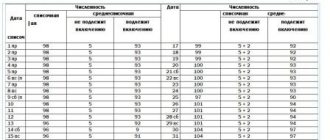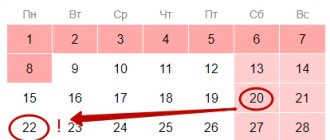For effective control and quality management, each enterprise maintains a regular number of employees. This indicator is important, so enterprise employees should not miss these parameters; the data should be constantly updated. The calculated value is entered into the reporting, which is compiled on the basis of legal requirements.
What are the differences between average and payroll numbers?
To begin with, it must be said that these rather consonant concepts, such as “average payroll” and “payroll” numbers, are completely different and should not be confused.
To correctly calculate the number (on the payroll) of all employees of the enterprise, we count each employee only once and this is absolutely independent of the factor, whether he worked the entire period or was not present at his workplace for any reason.
And, precisely, based on the above indicator, you will calculate the average number. In order to determine this data for all employees in your company for any one month, you need to proceed as follows: all working organizations on the list are summed up for each day of the period and this indicator is divided by all days of the same period.
The difference is also the following: certain employees must be taken into account in the number on the list, but they do not relate to the concept of the average payroll, for example:
Employees currently on parental leave or maternity leave.
When you need to make a calculation to collect the average number, you will need to take into account that employees who did not work all the time should not be counted in whole units for each day worked, but only in proportion to the time that was worked. Some categories may be exceptions. These include employees who were granted a reduced work schedule, which is in accordance with the legislation of the Russian Federation. Namely, these include, for example, people with disabilities.
More about time standards
In order to calculate full-time employees based on time standards, it is necessary to define them. This indicator represents the total cost of working time, which is set for a specific worker or their group under given technical and organizational conditions. At the same time, employees must meet a certain qualification level.
All work performed at the enterprise must be fully covered by temporary standards. This event allows you to obtain an accurate and objective number of staff.
Time standards are calculated with the mandatory inclusion of time costs. These include:
- research of legal provisions;
- creating and sending requests of interest;
- studying various data and materials from the industry in which the organization operates;
- implementation of planned plans and programs.
In addition, time standards usually include the costs necessary to carry out various activities aimed at achieving planned targets and various forms of final reporting.
Time standards can be determined to calculate the standard number of personnel. This indicator is entered into the report card.
Typically, the value of the indicator is determined for the financial year. The number of workers, according to the standards, is equal to the ratio of the total labor costs determined for the volume of work to the time fund for performing the work according to the plan.
When determining the value of the staffing level, it is important to correctly calculate not only the standard number, but also the absenteeism rate. This coefficient includes time for employee vacations, temporary disability, training, and advanced training. A mandatory element of accounting is correction factors, which are taken into account in temporary standards: time spent by workers on rest and on other personal needs during work.
Correct and competent calculation of the average number of employees
Suppose you need to calculate the number of employees in an organization for a certain period. For example, the billing period is a month.
We will make the calculation in this way: we will need to add up the number of employees for each day of a certain month according to the list, do not forget to include weekends, and now we divide the amount that is obtained by the sum of days in this billing period.
Initial data
To correctly determine the average headcount, you will need data.
The following may serve as initial data:
- A report card in the established form. Obviously, the average salary must be determined on the basis of the payroll number. And only daily strict accounting will help you determine the correct number from the list. It is precisely in order to accurately take into account the work done by all employees on a daily basis that a document such as a time sheet is needed.
- Production calendar. From the data of such a calendar you will get information about the number of days in the current month, etc.
The concept of a “whole unit”
Just keeping track of employees according to the list is not enough; you need to keep records correctly. And for this, you must know that all employees of the enterprise must be tested once in whole units, both those who actually worked and those who were absent from work.
Exceptions
But there are always exceptions to the rules. Our topic could not do without them. There are workers whom we should not and will not include in the headcount on the list. These include the following:
- working part-time, only externally;
- employees hired under civil contracts;
- employees who do not retain a salary while being sent to other organizations;
- employees attracted by contracts with government organizations;
- employees sent to study with a scholarship and taking time away from work;
- holders of the organization, only those who are not accrued salary.
General concept
The number of employees of a particular organization is the number of employees on staff of a particular enterprise. It can also be a number entered in the staffing table. Persons hired to perform certain duties for a season or for temporary work are not included in the staff. This definition is more often used in business planning when it is necessary to determine the number of personnel. In addition, it is often found in solving various management issues of the company.
The number of full-time employees at an enterprise may be noted in its charter, but this is not a mandatory provision. Most often, the determination of this indicator is calculated in government organizations. In various structural divisions of a commercial nature, it is rarely calculated. This is due to the fact that calculating the staff is quite difficult.
The staffing level is usually less than planned. Businesses often benefit from hiring employees for a specific period of time (temporary basis). This way, there is no need to add an employee to the staff and make regular wage payments, because the need for his services arises sporadically. In many countries there is a convenient recruitment system, which is based on the creation of special agencies. These organizations bring together various categories of workers. With the help of leasing operations, workers are temporarily transferred to the staff of production and business enterprises.
Formulas for calculating the average number of employees
Below are examples of several formulas that will be needed to calculate the number for different periods of time, for example, for the reporting month, as well as for the quarter and for the year:
Av/list number of employees per month = ∑List/number of days / K days, where
List/number of days – number according to the list of employees for calendar days of a given month;
To days – the sum of those same days of a certain period.
The average number of employees for any quarter is calculated using the following formula:
Average/list number of employees per quarter = ∑Average/list month / 3, where
Average/list of months – the sum of the average number of employees for all 3 months of the reporting quarter.
The average number of employees for the current year is calculated using the following formula:
Average/listed number for the year = ∑ Average/listed month/12, where
Average/list month – the sum of the average number of employees for all 12 months of the reporting year
Staff list of employees
Based on the staffing table and payroll of the organization's employees, a document such as the staffing list is issued.
It is one of those that are formed when documenting the same type of management functions of various organizations, regardless of their forms of ownership and other factors. Its compilation is prescribed by clause 74 of section 1.2 of the List, approved by Order of the Ministry of Culture of Russia dated August 25, 2010 N 558, which also establishes the storage periods for such documents.
staff list of employees
The number of employees is the number of employees needed with the help of which you can achieve your goals and develop the company. Beginning businessmen, especially in the early stages, have many questions related to this concept. How to calculate staffing levels, which specialists are needed first. Without understanding these issues, it will not be possible to launch even the smallest production or company.
Average number of employees per year
| Name of period | Average headcount, people |
| January | 500 |
| February | 503 |
| March | 510 |
| April | 511 |
| May | 511 |
| June | 515 |
| July | 516 |
| August | 517 |
| September | 520 |
| October | 520 |
| November | 521 |
| December | 521 |
| Total: | 6165 |
We determine the average headcount for the year in the following way: we sum up the average headcount for each month of the year and divide this amount by the number of months in the reporting period, that is, by 12 months.
In our example: (500+503+510+511+511+515+516+517+520+520+521+521)/12 = 6165/12=514 people.
Why is it necessary to determine staffing levels?
The number of employees is something that no successful and efficient enterprise can do without. It is important to take into account and monitor this indicator, since the ultimate success of your entire business depends on it.
It is necessary that the manager and head of the HR department do not forget to monitor these parameters and constantly update statistical data, providing relevant information. Data on the number of employees must be regularly entered into reporting documents. Their preparation is regulated by relevant legislation and requirements.
Average number of employees for the quarter
| Month | Average headcount, people |
| Month #1 | 500 |
| Month #2 | 503 |
| Month #3 | 510 |
| Total: | 1513 |
We determine the average headcount for any quarter in the following way: we sum up the average headcount for the months of the quarter, in this case, January-March, and divide this amount by 3 (number of months).
In our example: (500+503+510)/3 = 1513/3=504 people.
How to document the number of employees?
In order to ensure that the number of employees is officially recorded and there are no claims against you either from the tax authorities or from the labor inspectorate, it is necessary to carefully and scrupulously maintain the relevant documentation.
The number of employees is an indicator that it is advisable to include in the company’s charter. However, this is not a mandatory requirement. Typically, this indicator is calculated at large enterprises, mainly state-owned. This is strictly monitored there. On the contrary, in commercial structures it is given less importance, which is not always justified. Most experts are inclined to believe that it is necessary to carry out this accounting, even though this is often quite difficult to do.
Average number of employees per month
Let's give an example of calculating the average number of employees for one month (for example, let's take April 2015).
Date Number of employees on the list, people. Not included in the average headcount, people. Included in the average number, people.
1 500 – 500 2 500 – 500 3 501 – 501 4 (weekend) 501 – 501 5 (weekend) 501 – 501 6 512 – 512 7 511 – 511 8 520 – 520 9 520 – 520 10 520 – 520 11 (day off) 520 – 520 12 (weekend) 520 – 520 13 522 – 522 14 522 1 521 15 522 1 521 16 525 1 524 17 525 1 524 18 (weekend) 525 1 524 19 (weekend) 525 1 5 24 20 526 1 525 21 530 2 528 22 531 2 529 23 531 2 529 24 531 2 529 25 (weekend) 531 2 529 26 (weekend) 531 2 529 27 535 3 532 28 535 3 532 29 535 3 532 30 536 3 533 TOTAL: 15613
As can be seen from the table, for all days of this reporting period, the number of employees is 15613, the total number of days in April 2015 is 30, respectively, we get the number of employees that we were looking for, equal to 520 people (15613/30=520.43) . We indicate the number only in whole units.
Standard staffing standards
The headcount standard is the number of employees who have certain professional qualifications to perform certain managerial or production functions or in given organizational and technical conditions.
To calculate these standards, the composition or volume of work that is most typical for a given category of personnel is taken into account. Therefore, the indicator is not very accurate: with any deviation of the actual indicators from the standard indicators, the accuracy of the result decreases. Most often, standards are presented in the form of calculated dependencies or normative tables compiled on their basis. Thus, in Order of the Department of Education of the Tver Region No. 409 of May 31, 2005, the staffing standards for employees of educational organizations are calculated not from the actual, but from the estimated number of classes and extended day groups, depending on the occupancy rate of 25 people per class.
Report
The report on data on the average headcount is one of the very first of all reports that organizations submit to the territorial tax office. The following reports are submitted to the state statistics bodies: P4 and P4 (NZ).
Where to submit the report and how
A report on information on the average headcount must be submitted to the tax office at the place of registration of your organization or individual entrepreneur. It is provided both on paper in two copies and on a floppy disk. A report such as No. P-4 (NZ) and P4 is submitted to the statistical office. You can submit such a report electronically through a specially installed program, it is very convenient.
Due dates
The maximum deadline for submitting data on the average headcount for the past year is January 20 of the current year according to the approved form. Report P4 for organizations with no more than 15 people is submitted once a quarter, and if the number is more than 15 people, then such a report must be submitted once a month, no later than the 15th day of the month following the reporting one.
Regulatory regulation
The determination of the above indicators is prescribed by legislation and regulations in these areas.
The main issues of determining the payroll number and composition are regulated in:
- Instructions on statistics of the number and wages of workers and employees at enterprises, institutions and organizations, in force to date, approved. September 17, 1987 by the State Statistics Committee of the USSR (hereinafter referred to as the Instructions);
- Order of Rosstat dated August 3, 2015 N 357, which approved the statistical report form 57-T (hereinafter referred to as Order No. 357), and other orders.
It also determines who must submit these reports and within what time frame.
Total number of company employees
The coefficient is determined in strict accordance with the internal policy of the company.
As a rule, this is a calendar month, one quarter or one year (three hundred sixty-five calendar days).
The indicator is derived from the main provisions of the “Total number of employees” of the company, which includes part-time workers, payroll and specialists employed under an employment contract.
- Working on the basis of concluded contracts. They are specialists employed by a company on the basis of a concluded employment contract. These employees can fulfill work obligations at two enterprises at once. As long as the employment agreement is in effect, workers are counted as a complete unit.
- Part-timers. They are employees who are on the list of workers of another company, but at the moment they are fulfilling official obligations at this enterprise (at half the rate). Accounting is carried out only on the basis of the amount of time worked or wages received.
- Listed specialists. They are seasonal and permanent employees employed. Each worker can perform official duties only in one company.
Number of employees
Recommendations for determining the number of employees are closely related to such a concept as the number of staff. In essence, this is the product of the value of the standard number of employees and the corresponding coefficient, which should take into account the planned absence of personnel from work. Naturally, absenteeism takes into account only valid reasons, such as illness, maternity leave, business trips, and urgent family circumstances. In this way, the number of employees that your enterprise needs to function fully is determined, taking into account all possible life circumstances.
It is calculated like this. The planned employee absenteeism rate is added to the percentage of absenteeism, which, in turn, is converted into shares by systematically dividing by 100. This method of determining the number of employees is considered one of the most promising.
What is staffing and how to draw it up
This is a local regulatory act of the employer that determines the structure of the organization (number, composition, etc.). Rosstat approved it as form T-3. The schedule indicates the following details: the name of the departments indicating the code, the names of positions, specialties, professions, class, rank, etc., the number of subordinates indicating the salary (tariff), allowances.
In 2021, the sample number of employees in the T-3 form consists of 10 sections, filled out in accordance with the organizational structure of the enterprise.
First, we indicate the name of the organization in accordance with the statutory documents, OKPO code, serial number of the document according to the Document Registration Journal, date and number.
Let's move on to filling out the sections of the document.
In section 1 (“Name of the structural unit”) we indicate divisions, representative offices, and branches. First we register the management team, then - by department of all the others. For example, financial department, accounting, personnel, production data (workshops, sites, etc.).







